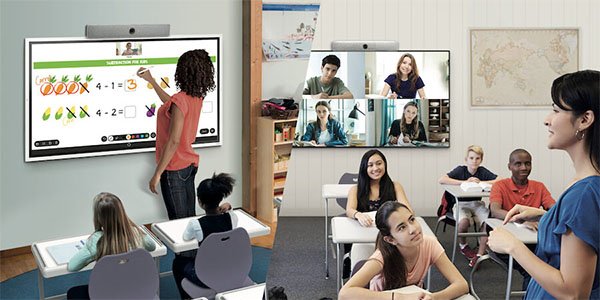With the wide application of information technology in the field of education, the smart board has become an indispensable tool for modern teaching. The use of smart boards has brought revolutionary changes to traditional teaching, bringing significant progress to students and teachers in three major areas.

First, the smart board realizes the enrichment and visualization of teaching content. Teachers can display multimedia courseware such as animations and videos through the smart board, making boring knowledge points lively and interesting. At the same time, the smart board supports operations such as handwritten notes and marks, making the explanation process more intuitive.
Second, the smart board shows the diversity of teaching methods. Teachers can carry out multi-person collaborative editing to realize the synchronous sharing of teaching plans. You can also use the teaching software on the smart board to conduct classroom tests, organize discussions and other teaching activities. These rich teaching modes enhance students’ sense of participation.
Third, the smart board realizes the personalization of the teaching paradigm. Students can use the smart board for independent learning and control their own learning progress. Teachers can also provide targeted guidance according to the individual situation of each student. This deepens the initiative and relevance of learning.
To sum up, the application of the smart board has brought revolutionary progress to traditional teaching and realized the upgrading of teaching content, method, and paradigm. Their popularization will better stimulate students’ learning interest and potential, and promote the overall improvement of teaching quality.

1. Rich application scenarios of smart board
Smart boards can not only be used in classroom teaching, but also enrich the after-school life of teachers and students. Teachers can use the smart board to organize students to carry out a variety of extracurricular activities, such as holding knowledge contests, developing interest groups, showing movies, etc. Students can also use the smart board in their spare time to conduct independent learning, conduct discussions, display works, etc. These applications have greatly enriched the content of school life.
2. Multiple Operation Modes Of The Smart Board
The smart board supports multiple operation modes such as multi-touch and stylus writing to meet the needs of different teaching scenarios. Teachers can flexibly use these operating modes for classroom teaching, organizing activities, and correcting homework. Students can also choose the appropriate operation mode according to their own learning habits.

3. Smart boards facilitate communication between teaching and learning
The interactive function on the smart board strengthens the communication and interaction between teachers and students. Teachers can guide students to express their views and exchange ideas through the functions of questioning and discussion areas on the smart board. Students can also ask their own questions using the smart board. This deepens the interaction between teaching and learning.
4. The Smart Board Promotes The Innovation Of Teaching Evaluation
Through the application of smart boards, the teaching evaluation has become procedural and diversified, and it no longer simply relies on pen and paper tests. Teachers can conduct process evaluations on students’ classroom performance and discussions. At the same time, various evaluation methods such as displaying works and comprehensive practice can be used.
5. Smart Boards Promote Educational Equity
The application of smart board narrows the difference in educational resources between urban and rural schools, students can share high-quality digital teaching resources, and promote educational equity. At the same time, the smart board can also launch auxiliary functions according to different needs to help students with special needs obtain equal educational opportunities.
continue reading




